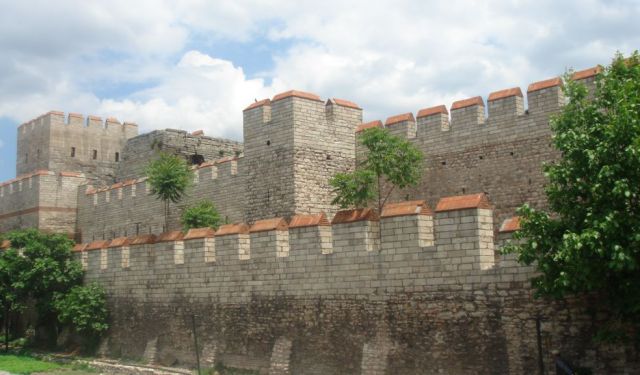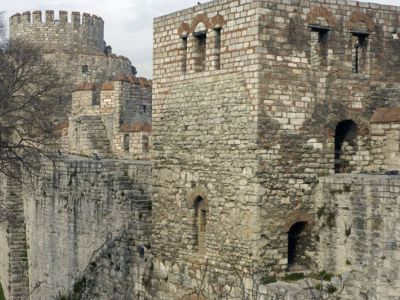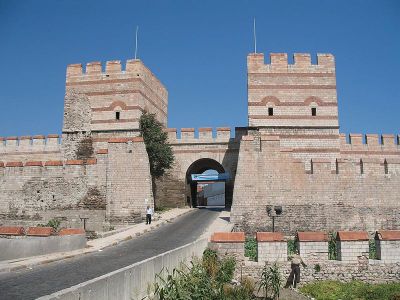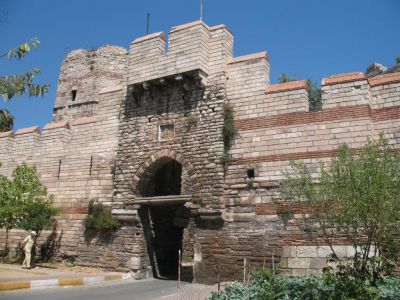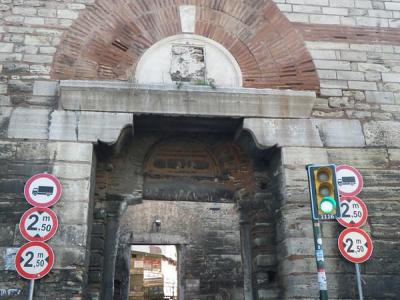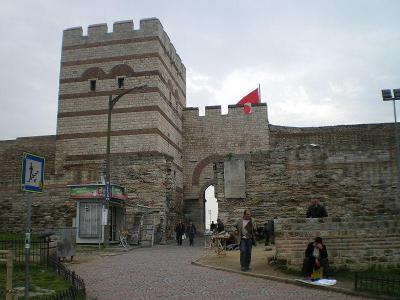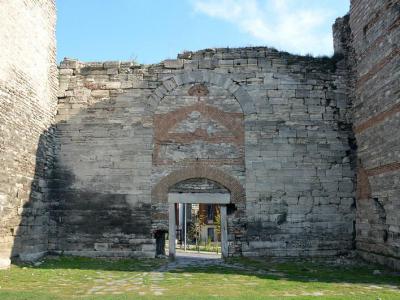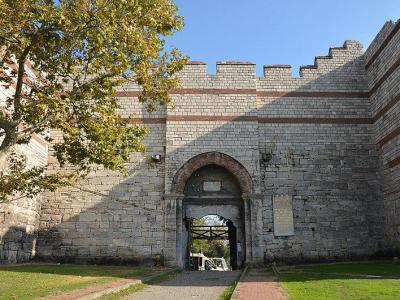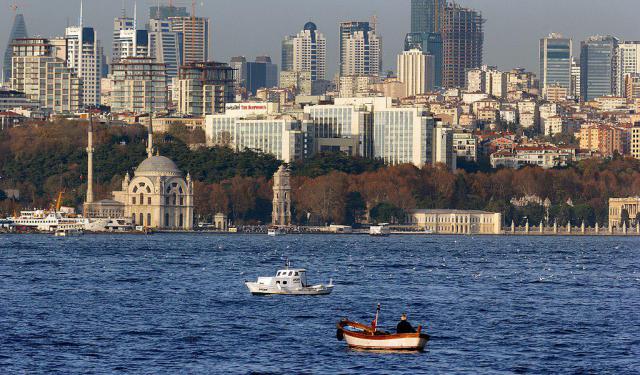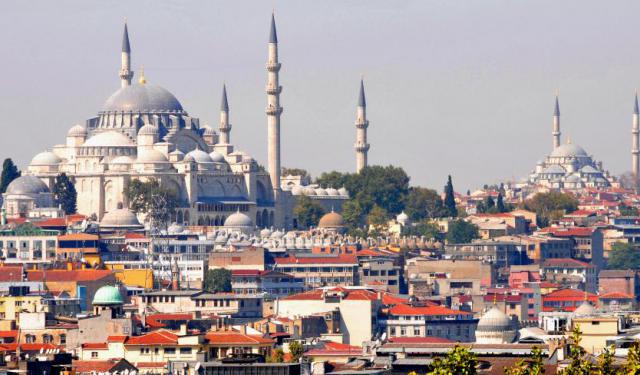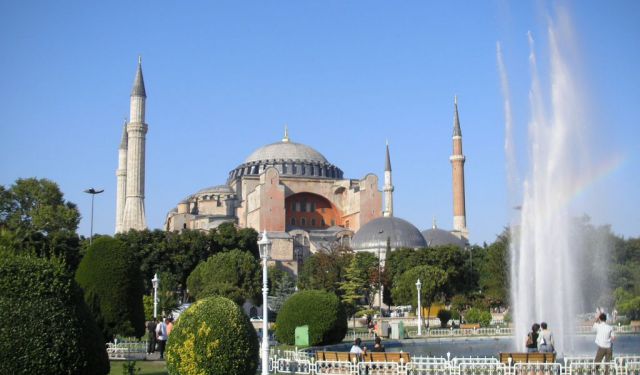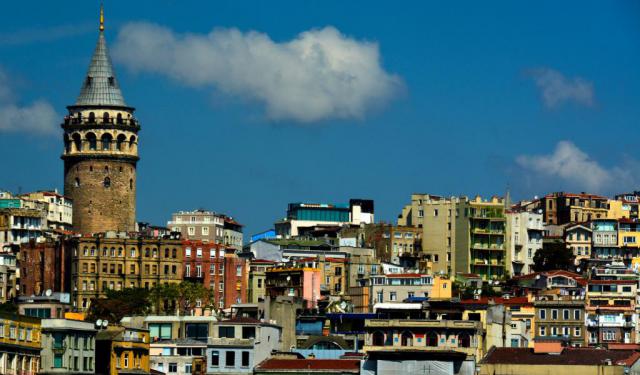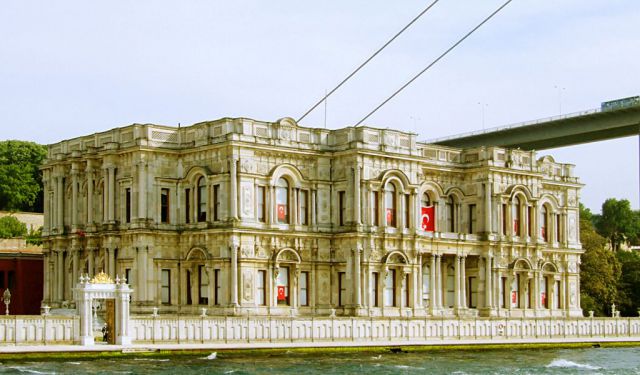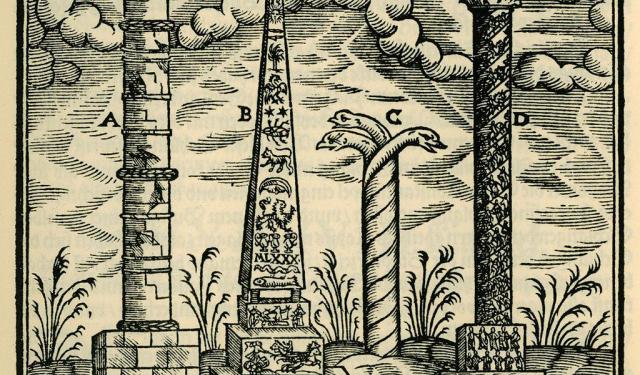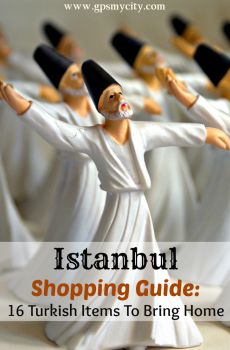Istanbul City Walls (Self Guided), Istanbul
One of the most elaborate fortification systems of ancient times, the Walls of Constantinople were built by Constantine the Great to protect the city, the then newly-established capital of the Eastern Roman Empire, from attacks by land and sea. Of these, only the Golden Gate, an old ceremonial gateway into the city, had survived by the late Byzantine Era when a new series of land walls were added during the reign of Emperor Theodosius II, in the 5th century AD.
Thanks to their strategic position, these incredible fortifications saved Constantinople time and time again from the armies of foreign invaders that crashed against them in vain. To this date, the Istanbul City Walls, also known as the Theodosian Walls, have remained in various states of preservation – some almost intact, some crumbling, and some undergoing restoration. All of them, however, provide a vital link to the city's past and are free to wander around (preferably during daylight).
One of the prominent structures within the walls is the Xylokerkos Gate, also known as the Gate of Belgrade. Next to it, the Gate of Spring, or Pege Gate, provided access to a vital water source which was essential for the city's water supply, especially during times of siege.
The Gate of Rhesios was another critical point in the city's defense system. It controlled access to the city and helped in repelling invaders.
The Gate of Saint Romanus, named after a Byzantine saint, was a part of the elaborate fortifications that secured the city from various angles.
The Fifth Military Gate: While its name may not be as famous, this gate served a critical role in the overall defense strategy, allowing for the movement of troops and supplies.
The Gate of Charisius was one of the gates that reinforced the city's security and played a role in its long-lasting protection.
Having stood strong for centuries against numerous invasions, these ancient structures are more than just historical relics but a testament to the engineering prowess of the Byzantine Empire. Walking along these fortification marvels can transport you back in time and allow you to appreciate the invaluable heritage and culture of Istanbul.
Thanks to their strategic position, these incredible fortifications saved Constantinople time and time again from the armies of foreign invaders that crashed against them in vain. To this date, the Istanbul City Walls, also known as the Theodosian Walls, have remained in various states of preservation – some almost intact, some crumbling, and some undergoing restoration. All of them, however, provide a vital link to the city's past and are free to wander around (preferably during daylight).
One of the prominent structures within the walls is the Xylokerkos Gate, also known as the Gate of Belgrade. Next to it, the Gate of Spring, or Pege Gate, provided access to a vital water source which was essential for the city's water supply, especially during times of siege.
The Gate of Rhesios was another critical point in the city's defense system. It controlled access to the city and helped in repelling invaders.
The Gate of Saint Romanus, named after a Byzantine saint, was a part of the elaborate fortifications that secured the city from various angles.
The Fifth Military Gate: While its name may not be as famous, this gate served a critical role in the overall defense strategy, allowing for the movement of troops and supplies.
The Gate of Charisius was one of the gates that reinforced the city's security and played a role in its long-lasting protection.
Having stood strong for centuries against numerous invasions, these ancient structures are more than just historical relics but a testament to the engineering prowess of the Byzantine Empire. Walking along these fortification marvels can transport you back in time and allow you to appreciate the invaluable heritage and culture of Istanbul.
How it works: Download the app "GPSmyCity: Walks in 1K+ Cities" from Apple App Store or Google Play Store to your mobile phone or tablet. The app turns your mobile device into a personal tour guide and its built-in GPS navigation functions guide you from one tour stop to next. The app works offline, so no data plan is needed when traveling abroad.
Istanbul City Walls Map
Guide Name: Istanbul City Walls
Guide Location: Turkey » Istanbul (See other walking tours in Istanbul)
Guide Type: Self-guided Walking Tour (Sightseeing)
# of Attractions: 7
Tour Duration: 2 Hour(s)
Travel Distance: 5.2 Km or 3.2 Miles
Author: DanaOffice
Sight(s) Featured in This Guide:
Guide Location: Turkey » Istanbul (See other walking tours in Istanbul)
Guide Type: Self-guided Walking Tour (Sightseeing)
# of Attractions: 7
Tour Duration: 2 Hour(s)
Travel Distance: 5.2 Km or 3.2 Miles
Author: DanaOffice
Sight(s) Featured in This Guide:
- Golden Gate
- Xylokerkos Gate / Gate of Belgrade
- Gate of Spring / Pege Gate
- Gate of Rhesios
- Gate of St. Romanus
- Fifth Military Gate
- Gate of Charisius
1) Golden Gate
The Golden Gate in Istanbul is an impressive reminder of the city's deep history from the Byzantine era. Located on the city's old walls' south-north line, it's the first gate you come across when moving in that direction. The Golden Gate was mainly used for grand ceremonies, like welcoming emperors back from wars, crownings, and occasionally, very special guests, including a few visits from popes in the years 519, 868, and a notable one from Pope Constantine in 710.
As the Byzantine Empire's military strength declined, changes were made to the gate; it was eventually sealed off and made smaller, turning into a sort of fortress. The Golden Gate didn't just leave a mark on Istanbul; it inspired the construction of similar grand gates in cities like Thessaloniki, Antioch, Kiev, and Vladimir, and even influenced the naming of the Golden Gate in San Francisco, California, as a tribute to Byzantine influence.
The exact time when the Golden Gate was built is still debated by historians, with opinions varying between the reigns of Theodosius I and II, though most agree it was likely the latter. From an architectural standpoint, the gate is known for its polished white marble, put together without any cement into a grand arch flanked by two smaller ones, and supported by two large towers. It was a busy passageway, decorated with statues including one of Theodosius I, and had seen damage from earthquakes and attacks over the years, losing many of its original decorations.
Even though it started as a ceremonial gate, the Golden Gate was also built strong enough to defend the city against attacks. Today, it stands as a testament to the greatness and strategic savvy of Byzantine Constantinople, reminding us of the city's historical importance and the legacies of its rulers.
As the Byzantine Empire's military strength declined, changes were made to the gate; it was eventually sealed off and made smaller, turning into a sort of fortress. The Golden Gate didn't just leave a mark on Istanbul; it inspired the construction of similar grand gates in cities like Thessaloniki, Antioch, Kiev, and Vladimir, and even influenced the naming of the Golden Gate in San Francisco, California, as a tribute to Byzantine influence.
The exact time when the Golden Gate was built is still debated by historians, with opinions varying between the reigns of Theodosius I and II, though most agree it was likely the latter. From an architectural standpoint, the gate is known for its polished white marble, put together without any cement into a grand arch flanked by two smaller ones, and supported by two large towers. It was a busy passageway, decorated with statues including one of Theodosius I, and had seen damage from earthquakes and attacks over the years, losing many of its original decorations.
Even though it started as a ceremonial gate, the Golden Gate was also built strong enough to defend the city against attacks. Today, it stands as a testament to the greatness and strategic savvy of Byzantine Constantinople, reminding us of the city's historical importance and the legacies of its rulers.
2) Xylokerkos Gate / Gate of Belgrade
The Xylokerkos Gate, also known as the Gate of Belgrade, is a historical landmark situated in Istanbul, nestled between towers 22 and 23 of the city's ancient fortifications. This gate, with its name stemming from its path to an external wooden circus (amphitheater), presents a striking structure approximately 12 meters in width and nearly 20 meters in height. Its architectural significance is matched by its rich historical tapestry, marked by closures and openings that reflect the city's tumultuous past.
A notable episode in the gate's history is detailed by the historian Niketas Choniates, who recounts that in 1189, Emperor Isaac II Angelos ordered the gate to be sealed. This decision was driven by a prophecy foretelling that Western Emperor Frederick Barbarossa would enter Constantinople through this very gate. The closure was a strategic move aimed at thwarting the fulfillment of this prophecy. However, the gate's destiny continued to unfold over the centuries, with its reopening in 1346. This event earned it the name of the Belgrade Gate, commemorating the influx of prisoners from Belgrade who settled nearby following the Ottoman conquest of Serbia under Sultan Suleiman I.
The gate's history is further marked by another closure before the pivotal siege of 1453, which led to the fall of Constantinople to the Ottomans. It remained sealed until 1886, a period during which it was known as Kapalı Kapı, or the "Closed Gate," in the early Ottoman era. This name encapsulates the gate's legacy of being more than just a point of passage; it was a symbol of the city's strategic vulnerabilities and its resilience in the face of prophecy and conquest.
Tip:
Climb the stairs on the right and left sides of the gate to get a different panorama of Istanbul via the defense towers.
A notable episode in the gate's history is detailed by the historian Niketas Choniates, who recounts that in 1189, Emperor Isaac II Angelos ordered the gate to be sealed. This decision was driven by a prophecy foretelling that Western Emperor Frederick Barbarossa would enter Constantinople through this very gate. The closure was a strategic move aimed at thwarting the fulfillment of this prophecy. However, the gate's destiny continued to unfold over the centuries, with its reopening in 1346. This event earned it the name of the Belgrade Gate, commemorating the influx of prisoners from Belgrade who settled nearby following the Ottoman conquest of Serbia under Sultan Suleiman I.
The gate's history is further marked by another closure before the pivotal siege of 1453, which led to the fall of Constantinople to the Ottomans. It remained sealed until 1886, a period during which it was known as Kapalı Kapı, or the "Closed Gate," in the early Ottoman era. This name encapsulates the gate's legacy of being more than just a point of passage; it was a symbol of the city's strategic vulnerabilities and its resilience in the face of prophecy and conquest.
Tip:
Climb the stairs on the right and left sides of the gate to get a different panorama of Istanbul via the defense towers.
3) Gate of Spring / Pege Gate
The Gate of the Spring or Pēgē Gate was named after a popular monastery outside the Walls, the Zōodochos Pēgē ("Life-giving Spring") in the modern suburb of Balıklı. It lies between the heptagonal towers 35 and 36, which were extensively rebuilt in later Byzantine times: its southern tower bears an inscription dated to 1439 commemorating repairs carried out under John VIII Palaiologos. In addition, in 1998 a subterranean basement with 4th/5th-century reliefs and tombs was discovered underneath the gate.
It was through this gate that, on 25 July 1261, the forces of the Empire of Nicaea, under General Alexios Strategopoulos, unexpectedly entered and retook the city, which had been the seat of the Latin Empire since its capture by the Fourth Crusade in 1204. Having learned from some independent local farmers that the entire Latin garrison, as well as the Venetian fleet, were absent conducting a raid against the Nicaean island of Daphnousia, Strategopoulos and his men attacked the walls from the inside, surprised the guards and opened the gate, giving the Nicaean force entry into the city. The Latins were taken completely unaware, and after a short struggle, the Nicaeans gained control of the land walls. Thanks to the timely arrival of the returning Venetian fleet, many of the Latins managed to evacuate to the Latin-held parts of Greece, but the city was lost for good. The recapture of Constantinople signaled the restoration of the Byzantine Empire, and on 15 August, Emperor Michael VIII entered the city in triumph and was crowned at the Hagia Sophia.
It was through this gate that, on 25 July 1261, the forces of the Empire of Nicaea, under General Alexios Strategopoulos, unexpectedly entered and retook the city, which had been the seat of the Latin Empire since its capture by the Fourth Crusade in 1204. Having learned from some independent local farmers that the entire Latin garrison, as well as the Venetian fleet, were absent conducting a raid against the Nicaean island of Daphnousia, Strategopoulos and his men attacked the walls from the inside, surprised the guards and opened the gate, giving the Nicaean force entry into the city. The Latins were taken completely unaware, and after a short struggle, the Nicaeans gained control of the land walls. Thanks to the timely arrival of the returning Venetian fleet, many of the Latins managed to evacuate to the Latin-held parts of Greece, but the city was lost for good. The recapture of Constantinople signaled the restoration of the Byzantine Empire, and on 15 August, Emperor Michael VIII entered the city in triumph and was crowned at the Hagia Sophia.
4) Gate of Rhesios
The Gate of Rhesios, situated within the historic Theodosian Walls of Istanbul, emerges as a testament to the city's Byzantine heritage. Esteemed as the best-preserved and amongst the most fascinating gates of this ancient defensive barrier, it retains its original appearance from the 5th century. Its nomenclature, as documented in the 10th-century Suda lexicon, honors an ancient general of Greek Byzantium, suggesting a rich historical narrative tied to its construction and purpose.
In early modern texts, this gate is known as the Gate of Rhegion or the Gate of Rhousios, possibly named after the nearby suburb of Rhegion or the hippodrome faction of the Reds. This latter designation hints at the socio-political intricacies of Byzantine society, where the support of such factions could influence public works, including the repair and maintenance of significant urban structures like this gate.
A distinctive feature of the Gate of Rhesios is the exceptional number of inscriptions adorning its tower, with at least six recorded instances. These inscriptions serve not only as historical documents but also as a medium through which the aspirations and devotions of the time are communicated. Among these, the most frequently cited inscription, "The Fortune of Constantine, Our God-Protected Despot, Triumphs...", encapsulates the intertwining of divine providence with the imperial authority of Constantinople's rulers.
The Gate of Rhesios, through its architectural integrity, historical significance, and the rich tapestry of inscriptions it bears, stands as a silent witness to the Byzantine Empire's grandeur and complexity. It not only embodies the defensive might of a bygone era but also encapsulates the cultural and political narratives that shaped the history of Istanbul, bridging the ancient and medieval worlds.
In early modern texts, this gate is known as the Gate of Rhegion or the Gate of Rhousios, possibly named after the nearby suburb of Rhegion or the hippodrome faction of the Reds. This latter designation hints at the socio-political intricacies of Byzantine society, where the support of such factions could influence public works, including the repair and maintenance of significant urban structures like this gate.
A distinctive feature of the Gate of Rhesios is the exceptional number of inscriptions adorning its tower, with at least six recorded instances. These inscriptions serve not only as historical documents but also as a medium through which the aspirations and devotions of the time are communicated. Among these, the most frequently cited inscription, "The Fortune of Constantine, Our God-Protected Despot, Triumphs...", encapsulates the intertwining of divine providence with the imperial authority of Constantinople's rulers.
The Gate of Rhesios, through its architectural integrity, historical significance, and the rich tapestry of inscriptions it bears, stands as a silent witness to the Byzantine Empire's grandeur and complexity. It not only embodies the defensive might of a bygone era but also encapsulates the cultural and political narratives that shaped the history of Istanbul, bridging the ancient and medieval worlds.
5) Gate of St. Romanus
The Gate of Saint Romanus (Porta Agiou Rōmanou) holds a significant place in the history of Istanbul, particularly during the era of Constantinople. This historic gateway, now colloquially referred to as Cannon Gate, is famed for its role during the last siege of Constantinople. Its modern name, "Cannon Gate," is derived from the placement of the great cannon, the "Basilic," by the defending forces opposite the gate in a desperate attempt to fend off attackers.
Positioned strategically along the land walls of Constantinople, the Gate of Saint Romanus was named after a nearby church, embodying the rich religious and cultural history of the area. During the critical moments leading up to the fall of Constantinople, Emperor Constantine XI established his command post here, marking the gate as the central and most threatened stretch of the city's fortifications.
The Gate of Saint Romanus also served as a pivotal entrance point for the Ottoman forces led by Mehmed II during the historic conquest of Constantinople in 1453. This event marked a significant turning point in the city's history, transitioning from Byzantine to Ottoman rule.
Geographically, the gate is situated near the peak of the Seventh Hill of Istanbul, approximately 68 meters above sea level. The land walls then descend into the valley of the Lycus River, reaching their lowest elevation at 35 meters, before climbing the slope of the Sixth Hill. It is here that the walls rise again towards the Gate of Charisius (or Gate of Adrianople), standing at about 76 meters in height. The wall rises and falls as it approaches the Blachernae section, ending at the coastal plain by the Golden Horn and the renowned Prisons of Anemas.
Positioned strategically along the land walls of Constantinople, the Gate of Saint Romanus was named after a nearby church, embodying the rich religious and cultural history of the area. During the critical moments leading up to the fall of Constantinople, Emperor Constantine XI established his command post here, marking the gate as the central and most threatened stretch of the city's fortifications.
The Gate of Saint Romanus also served as a pivotal entrance point for the Ottoman forces led by Mehmed II during the historic conquest of Constantinople in 1453. This event marked a significant turning point in the city's history, transitioning from Byzantine to Ottoman rule.
Geographically, the gate is situated near the peak of the Seventh Hill of Istanbul, approximately 68 meters above sea level. The land walls then descend into the valley of the Lycus River, reaching their lowest elevation at 35 meters, before climbing the slope of the Sixth Hill. It is here that the walls rise again towards the Gate of Charisius (or Gate of Adrianople), standing at about 76 meters in height. The wall rises and falls as it approaches the Blachernae section, ending at the coastal plain by the Golden Horn and the renowned Prisons of Anemas.
6) Fifth Military Gate
The Fifth Military Gate lies immediately to the north of the Lycus stream, between towers 77 and 78, and is named after the quarter of the Pempton ("the Fifth") around the Lycus. Heavily damaged, with extensive late Byzantine or Ottoman repairs evident, it is also called Hücum Kapısı ("Assault Gate") in Turkish, because here the decisive Turkish breakthrough was achieved on the morning of 29 May 1453.
Some earlier scholars identify this gate as the one mentioned in the texts on the final siege and fall of Constantinople. If this theory is correct, the last Byzantine emperor, Constantine XI, died in the vicinity of this gate during the final Ottoman assault. Support to this theory comes from the fact that the particular gate is located at a far weaker section of the walls than the "Cannon Gate", and the most desperate fighting naturally took place here.
Although the gate itself is absent, visitors can actually stand in the place where the Theodosian Wall was firstly breached in over a millennium.
Some earlier scholars identify this gate as the one mentioned in the texts on the final siege and fall of Constantinople. If this theory is correct, the last Byzantine emperor, Constantine XI, died in the vicinity of this gate during the final Ottoman assault. Support to this theory comes from the fact that the particular gate is located at a far weaker section of the walls than the "Cannon Gate", and the most desperate fighting naturally took place here.
Although the gate itself is absent, visitors can actually stand in the place where the Theodosian Wall was firstly breached in over a millennium.
7) Gate of Charisius
The Gate of Charisius, also known as the Adrianople Gate, stands as a monument of significant historical importance in Istanbul. Occupying a strategic position on the highest of Istanbul's seven hills, this gate is renowned for its pivotal role in the city's history, particularly during the final moments of the Byzantine Empire and the dawning of the Ottoman era.
This gate, second in importance only to the Golden Gate, was the focal point of defense during the city's siege. It was here that the last Byzantine Emperor made a valiant stand in defense of Constantinople, marking a momentous chapter in the city's storied past. The historical significance of the Gate of Charisius is further underscored by the events following the fall of Constantinople in 1453. It was through this gate that Mehmed the Conqueror, the first Sultan of the Ottoman Empire, made his triumphant entry into the city. This act marked the conquest of Constantinople and signaled the ascendance of the Ottoman Empire as a dominant regional power.
Mehmed the Conqueror's capture of Constantinople marked a pivotal moment for the Ottoman Empire, elevating its status significantly. Ten years later, Mehmed II visited Troy, symbolically connecting his triumph to ancient lore. He proudly claimed to avenge the Trojans by defeating the Greeks (Byzantines), revealing his deep historical awareness and the belief in fulfilling destiny through his conquests.
The Gate of Charisius, therefore, is not just a physical gateway into the city of Istanbul; it is a portal into the rich tapestry of history that encompasses the rise and fall of empires, the continuity of ancient vendettas into the modern age, and the perpetual cycle of conquest and reconquest that has defined the region for millennia.
This gate, second in importance only to the Golden Gate, was the focal point of defense during the city's siege. It was here that the last Byzantine Emperor made a valiant stand in defense of Constantinople, marking a momentous chapter in the city's storied past. The historical significance of the Gate of Charisius is further underscored by the events following the fall of Constantinople in 1453. It was through this gate that Mehmed the Conqueror, the first Sultan of the Ottoman Empire, made his triumphant entry into the city. This act marked the conquest of Constantinople and signaled the ascendance of the Ottoman Empire as a dominant regional power.
Mehmed the Conqueror's capture of Constantinople marked a pivotal moment for the Ottoman Empire, elevating its status significantly. Ten years later, Mehmed II visited Troy, symbolically connecting his triumph to ancient lore. He proudly claimed to avenge the Trojans by defeating the Greeks (Byzantines), revealing his deep historical awareness and the belief in fulfilling destiny through his conquests.
The Gate of Charisius, therefore, is not just a physical gateway into the city of Istanbul; it is a portal into the rich tapestry of history that encompasses the rise and fall of empires, the continuity of ancient vendettas into the modern age, and the perpetual cycle of conquest and reconquest that has defined the region for millennia.
Walking Tours in Istanbul, Turkey
Create Your Own Walk in Istanbul
Creating your own self-guided walk in Istanbul is easy and fun. Choose the city attractions that you want to see and a walk route map will be created just for you. You can even set your hotel as the start point of the walk.
Bosphorus Coast Walking Tour
One of the planet's most praised stretches of water, the Bosphorus is a source of great pride for Istanbulites and of admiration for travelers. The 30-km strait dividing Europe and Asia and connecting the Marmara with the Black Sea is one of the city's highlights, having been for all ages the subject of legend and art.
This self-guided walk will take you along the coast so that you... view more
Tour Duration: 3 Hour(s)
Travel Distance: 5.9 Km or 3.7 Miles
This self-guided walk will take you along the coast so that you... view more
Tour Duration: 3 Hour(s)
Travel Distance: 5.9 Km or 3.7 Miles
Istanbul Old City Walking Tour
The Old City of Istanbul, occupying a triangular peninsula between the Golden Horn and the Sea of Marmara, is one of the most historically layered urban areas in the world. Its evolution reflects a succession of empires that shaped its architecture, culture, and spiritual life. The city’s origins date to around 657 BC, when Greek settlers from Megara founded Byzantium for its ideal harbor and... view more
Tour Duration: 2 Hour(s)
Travel Distance: 2.3 Km or 1.4 Miles
Tour Duration: 2 Hour(s)
Travel Distance: 2.3 Km or 1.4 Miles
Istanbul Introduction Walking Tour
Once called Byzantium, Constantinople, and New Rome, Istanbul has had more name changes over the years than a celebrity avoiding paparazzi... The largest city in Turkey and one of the world’s most historic urban centers, it straddles the Bosphorus Strait like it couldn’t decide whether to sit on its European or Asian side and ultimately opted for both. The result was a cultural smoothie... view more
Tour Duration: 2 Hour(s)
Travel Distance: 4.3 Km or 2.7 Miles
Tour Duration: 2 Hour(s)
Travel Distance: 4.3 Km or 2.7 Miles
Old European Quarter Walk
Back in the Ottoman era, the Beyoğlu neighborhood (then known as Pera), together with Galata, formed the stylish European Quarter of Istanbul. Home to embassies, trading houses, and Parisian-style apartment blocks, it all looks like it wandered in straight from the French capital. This area was where the city’s non-Islamic communities worked, lived, and possibly argued over the best pastries...... view more
Tour Duration: 2 Hour(s)
Travel Distance: 2.4 Km or 1.5 Miles
Tour Duration: 2 Hour(s)
Travel Distance: 2.4 Km or 1.5 Miles
Asian Side and Bosphorus Walking Tour
Istanbul is the only megalopolis in the world that straddles two continents. The Bosphorus Strait splits Turkey's biggest city into two parts: European and Asian. The latter, known locally as Asya Yakası (“Asian Side”), or more commonly as Anadolu Yakası (“Anatolian Side”), is found east of the strait, geographically on the Asian mainland.
The vast Anatolian shore, wrongly... view more
Tour Duration: 2 Hour(s)
Travel Distance: 4.6 Km or 2.9 Miles
The vast Anatolian shore, wrongly... view more
Tour Duration: 2 Hour(s)
Travel Distance: 4.6 Km or 2.9 Miles
Byzantine Heritage Walking Tour
Originated as a Greek city called Byzantium, what's now known as Istanbul initially made name as Constantinople, an Eastern Roman imperial capital whose greatness had lasted for over a millennium, from 330 AD until the Ottoman invasion in 1453.
The Byzantine Empire’s rich cultural and architectural heritage is still preserved in dazzling sites throughout the city. Away from its Islamic... view more
Tour Duration: 2 Hour(s)
Travel Distance: 2.5 Km or 1.6 Miles
The Byzantine Empire’s rich cultural and architectural heritage is still preserved in dazzling sites throughout the city. Away from its Islamic... view more
Tour Duration: 2 Hour(s)
Travel Distance: 2.5 Km or 1.6 Miles
Useful Travel Guides for Planning Your Trip
Istanbul Shopping Guide: 16 Turkish Items To Bring Home
Istanbul, known throughout history as Byzantium and Constantinople, has been a major center of commerce and trade, a place where merchants and general folk would rush to regularly in search of exotic things. In our days, modern travelers to Istanbul are also bound to enjoy a truly magnificent...
The Most Popular Cities
/ view all
